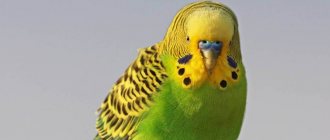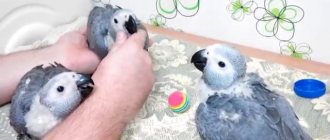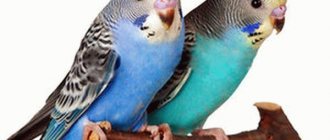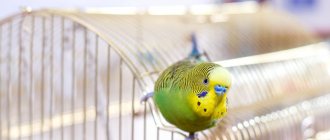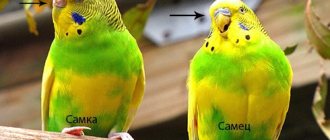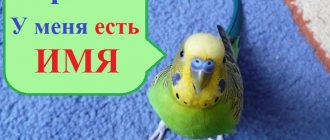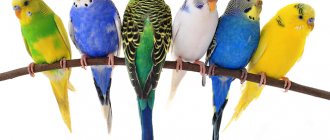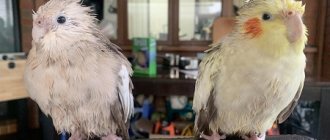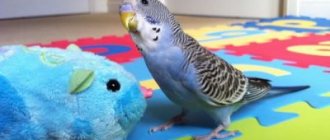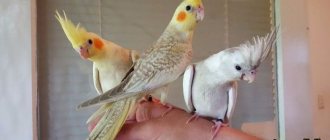Budgerigars are sensitive to changes in their surroundings, new people, and unfamiliar sounds and smells. Therefore, accustoming a budgie to a new person is not easy; the process requires patience and special knowledge.
We'll find out how to get a budgie used to being handled, and we'll figure out what needs to be done to overcome the bird's fear of humans.
Acquaintance and adaptation
Changes in a bird's life, such as moving to a new owner, are always stressful. Like any living creature, a parrot needs time to accept them. It is normal for budgies to be afraid of new environments and people for the first 4-6 days.
In order for acquaintance and adaptation to be successful, it is necessary:
- give the bird enough time;
- take into account its characteristics (breed, character, health and age);
- act within certain rules;
- Communicate regularly with your pet, but do not impose.
During adaptation to a new home, it is better not to bother the bird. When the budgerigar gets comfortable in the cage, you can approach him for a short time and talk calmly.
Establishing communication with a little friend should occur on terms of mutual respect. You can't put your hands in the cage. A bird that is not accustomed to you will regard this as aggression.
We are looking for mutual understanding
It happens that the parrot does not respond to all the efforts of the owner and resists making contact. Any learning process is labor-intensive and requires patience.
The main reason why a parrot does not seek to get closer is fear. There are many sources: noise, the constant presence of strangers, harassment, darkness or animals in the house. In this case, it is important to understand what exactly is the cause of fear. To begin with, eliminate the source, then gradually indicate its presence, encouraging the bird. The next step is to systematically become familiar with the cause of the fear, and then try to build trust and a sense of security.
Budgerigars are naturally endowed with curiosity and communication. The main thing in taming is not to suppress the bird with your desires and not to force them to actions that frighten them. Trust between pet and owner is the key to a long friendship.
Hand training
It is better for owners to immediately understand that it will not be possible to teach a budgie to sit on your hand soon. Birds have a very strong instinct of self-preservation. Therefore, it will not be possible to quickly tame a budgie. We'll have to be patient.
The main condition for successful training is mutual trust. When the bird understands that it is safe, training will go faster. There are several ways to train budgies.
Basic Rules:
- regularity of classes;
- absence of violence.
The easiest way to tame a budgie is to train it with treats. At first you should just feed him and calmly offer him a treat. It wouldn’t hurt to observe what the bird likes most.
Gradually, your pet will get used to associating your presence with positive emotions. In the future, this will ensure the bird’s friendly attitude and the emergence of trust.
After a while, you can offer your parrot a treat in your open palm. At first the bird will be slightly scared and will not take the food. Then you need to remove your hand. When your pet gets hungry, you should try again. If it fails again, you can clear your pet's feeder of food in the late afternoon. It will be much easier to handle your budgie in the morning, even if he is still a little afraid.
Interesting! The ideal age for training budgerigars is 5–6 months.
Over time, the bird gets used to having a positive attitude toward the hand with a treat, and then begins to sit on the owner’s fingers. This does not mean that you have managed to tame a budgerigar. You need to continue training and try to teach your pet to sit on your hand without a treat. Do not skimp on praise; sitting on an empty palm is the height of trust for a bird.
Features of taming budgies
To tame any budgie you will need a certain amount of patience, perseverance and a desire to make friends with the bird. First of all, you need to keep in mind that it is easiest for young individuals to begin to communicate and “make friends” with a person, preferably chicks before their first molt. Adult and elderly birds already have their own “life experience”, which either tells them that they can live without a person, or is generally negative towards people.
Breeders who specialize in breeding these birds recommend starting to “get to know” the chosen bird before purchasing it. Remember that it is very difficult to tame a wild, untrained budgie. And even with chicks it’s worth taking a closer look, choosing based on the following criteria:
- Decide on an individual. Young birds are easier to tame, and males are more sociable than females.
- If a bird communicates in its flock, it does not really need a person. Ask the owner to place the selected parrot in a separate cage. You can purchase it in advance, and then pick it up - at the same time, the pet will not experience stress, since it will already be “at home”.
- Like people, birds have different personalities. Taming a particular budgie can be more difficult or easier, depending on its sociability and temperament. The birds that make contact best are the “sanguine” birds - sociable, sociable, cheerful. The most difficult thing is with fearful “melancholic people”.
- You should come to the selected chick for several days, communicate with it, talk, give pieces of fruit through the bars of the cage. This taming strategy will continue after the bird moves to you, but at this stage you can look at the general behavior of the selected parrot, its sociability and desire to communicate.
Sometimes the future owner does not have the opportunity to look closely at the bird for a long time. However, it is worth immediately noting that purchasing parrots in random places, such as “bird markets,” is undesirable: the birds are treated poorly there, kept in cramped cages, often in the cold or in extremely crowded situations. All this causes chronic stress in birds, after which they, at best, become very timid and almost unsuitable for taming.
As for pet stores, there are different options - from those almost no different from the bird market, to more or less comfortable. This can be determined by the conditions of placement - parrots, on the one hand, do not like loneliness and isolation, but on the other hand, if cages with birds are in plain sight, this will also cause stress. Optimal location: with enough light, several individuals in a large and spacious space, without access to visitors.
Communication with a parrot outside the cage
Walking around the room and free flights are very important for the health of feathered friends. As a rule, it is not immediately possible to train budgies to get out of their usual house. These birds are very careful.
It is recommended to teach a parrot to leave its home as follows:
- open the door;
- move away 2–3 m and call your pet;
- show the bird a treat in your open palm and call it in a low voice.
The pet's first independent flights from the cage end in quick returns. The bird prefers to eat the obtained delicacy in a familiar environment. You can't blame her for this. Attempts should be repeated.
Soon the budgerigar will no longer be afraid of the room, and will deal with treats right in the palm of the owner. After a few more days, he will begin to fly out of the cage without food stimulation, and he will want to communicate with a person. Calm conversation, no sudden movements and affection will help you build your parrot's trust.
Let the bird get used to it
Do not forget that for a budgerigar, sitting in a person’s arms is stressful. After purchasing a pet, you need to give it time to get used to its new shelter a little. Making sudden movements or shouting loudly near the cage is not recommended in the first few weeks. You shouldn’t expect that a new family member will become tame in just a couple of days - you need to be patient. Cleaning the cage, changing the water or feeding bowl should be done carefully and smoothly, without sudden movements.
It is best to place a budgerigar's house in a place so that the animal can clearly see its owners and can recognize members of the household. Don't forget to talk to the bird, repeat its name, speak calmly and friendly.
For those who do not know how and when to tame a budgie if it is afraid, you should pay attention to the following fact. If a pet calmly eats its food in the presence of its owner and does not panic, then this is a good sign. The bird should also not react negatively to movements from the side of the cage and calmly go about its business. This behavior indicates that it is time to move on to learning.
Learning simple tricks
Budgerigars are very musical. While singing, they often dance. Many breeders use this skill to teach birds to dance at the owner’s request.
It's not too difficult to do this. The main thing is that the “student” is tame. If a parrot is recently purchased, it must first adapt, then get used to being handled, and only after that can it be taught simple tricks.
Classes are held daily, 10–15 minutes. The parrot, who sits on the hand, is given dynamic melodies to listen to. The music shouldn't be too loud. Many wavy pets begin to dance on their own.
If this does not happen, the bird needs to be taught to move to the music:
- put on hand;
- turn on the music;
- move your hand rhythmically and shake your head to the beat.
Each training session must end with praise from the bird. Regular training with wavy pets always gives good results.
Two steps to eliminate fear
- All of the above and other fears are justified and natural. But owners can give their parrot a sense of security and calm by gradually training their feathered friend. It is important to understand why the parrot is afraid! Watching a bird and understanding the causes of phobias can radically change the situation in a positive direction. First of all, you need to get the bird to trust you. For some birds this is a fairly slow process. And the owner needs patience and time to let his pet get comfortable.
- The best way to combat the fear of new things is through positive reinforcement. The essence of positive reinforcement is that the owner of the bird reinforces the positive emotions of the pet during any correct action by praise, favorite things or treats for the birds.
How to tame an adult parrot
It is easier to tame a young parrot, especially if it is a male. An adult requires a longer period of training. It is quite difficult to tame an adult parrot that has not been handled before, even if it is a boy.
Work with birds is carried out according to the same scheme as with young birds:
- gaining trust;
- hand training inside the cage;
- departures from home with landing on hand.
Experts advise increasing the duration of training with an adult bird to 20–25 minutes. The number of lessons per day is at least two. It has been noticed that taming adult female parrots is more difficult. On average, females get used to hands in about a month.
Unusual ways
If you have no idea how to teach a parrot to sit on your hand, try an unconventional teaching method. To do this, it is enough to trim the flight feathers on the wings. The bird will not be able to fly and will be forced to sit on the palm. But after the feathers grow, there is no guarantee that the bird will be tamed.
There is another recommendation that allows you to train a parrot in just a few days. Place both palms into the cage at once and keep them there. When the pet gets tired of fluttering, he will climb into your arms. On the fourth day of such experiments, the bird gets used to its new owner. But this method is not suitable for everyone, as it puts a strong strain on the psyche. The parrot will sit on your hands, but will still be afraid.
Important information
Unless there is an urgent need, there is no need to rush into training a new pet. A parrot's training begins only when it:
- Healthy;
- got used to the new place of residence;
- met and made friends with all family members;
- began to behave relaxed in the new house (plays, sings, flies, etc.).
Strictly prohibited:
- Trying to grab the bird;
- impose communication on the pet.
Each of these and similar actions deals a powerful blow to the psyche of a small defenseless bird. You can forget about the possible taming of such a frightened bird.
Training a parrot is a rather complicated and painstaking task. The main characteristics of proper training are:
- Accuracy;
- delicacy;
- gradualism;
- regularity.
Lessons should be held in a calm and measured manner. Harshness and assertiveness will only frighten the bird, and it will lose its barely born trust in its owners. The basis of proper training is patience - unlimited, no matter how long the learning process lasts, since the slightest disruption will negate all the results achieved up to that point. For all correctly completed tasks, the parrot should be affectionately praised - this will stimulate the bird to achieve further goals.
In addition, it is important to control the stages of training. If any stage is not completed and its result is not perfected, you cannot move on to the next stage of training. Accelerating the passage of stages will not bring success - the parrot will never be tamed.
It is also worth noting that the reaction to taming differs in birds of different breeds, but does not depend on the gender of the parrot (that is, girls and boys of the same breed are trained in the same way).
The champions for ease of taming are the wavy ones. They are followed by lovebirds. If you follow the rules, you can quite easily train a gullible Rosella, and it is also easy to accustom a kakarika to your hands. The ease of training and learning is directly related to the gullibility and fearfulness of birds. Therefore, the cockatiel, which has been eyeing people for a long time, is more difficult to tame than wavy birds and lovebirds. It is quite difficult to train a timid finch parrot.
Comfortable conditions
Before buying a parrot, think through all aspects of the pet’s comfortable living conditions, read the recommendations of experts, chat on forums and among your friends with those who have parrots.
When purchasing the necessary attributes, pay attention to the materials from which they are made
The cage should be spacious so that the parrot can move freely around it, spread its wings and wave them, jump from perch to ladder, and play with toys. The feeder usually comes with the cage. It is better to choose a ceramic or porcelain drinker rather than plastic. It costs more, but in such dishes harmful microflora develops more slowly, and the water stays clean longer. Choose toys made from environmentally friendly materials with high-quality coating.
In comfortable conditions, the bird will more easily bear the stress of moving to a new home.
What is prohibited to do
If a person wants to tame a wavy quickly, then some erroneous actions should not be taken.
These include:
- on the first day, try to feed the parrot only by hand, since you first need to wait for the pet to adapt to the environment;
- stroke or pick up forcibly when there is still no trust on the part of the bird;
- scream or show aggression towards the wavy;
- swing your arms at the bird;
- clipping the wings, which negatively affects the psyche of the bird.
Only patience and a good attitude allows you to get a kind and sociable parrot.
It is also useful to read: Life expectancy of budgerigars
Amazon
This species includes 25 species that live in South and Central America. They are considered one of the best imitators of speech; they have a higher ability to imitate than the Gray Gray, although they are somewhat inferior in intelligence. They are affectionate to humans, have a friendlier character, and tolerate captivity well. On average, they can learn 80-100 words and also speak in short sentences. Amazon parrots can also perform simple circus tricks, reproduce the tones of musical instruments, whistle melodies, imitate animals and the sounds of nature.
These are one of the few parrots that do not hesitate to speak in the presence of a person and love attention to themselves. The best option for keeping in captivity are white-headed, yellow-winged, blue- and red-fronted, Brazilian and Venezuelan Amazons
Does the wavy require steam?
If the owner pays a lot of attention to his pet, then the wavy does not need additional communication. A small cage is suitable for keeping one individual, and the bird easily makes contact with humans. It is very easy to teach her to speak, and also the wavy rejoices at the arrival of a person. If birds are in each other’s company from a young age, then they are not drawn to people.
A lonely pet gets bored when left alone, so if a person spends a lot of time at work or with friends, then it is advisable to find a mate for your pet.
Release
Birds are born to fly. A pet parrot, confined to a cage, also wants to feel free. When the main stages of taming the cockatiel have been completed, you can allow it to go for walks. Before opening the door, the space needs to be secured as much as possible:
- remove animals;
- take out the plants;
- hide small items;
- close windows and doors.
Having prepared the room, they open the cage and try to lure the parrot out. One way is to bring your hand to the bird, and when it sits down, slowly pull it out. If the cockatiel is showing anxiety, do not rush it. You need to encourage your pet, and it will begin to flutter freely.
Attention! After a walk, the parrot must return to the cage on its own. You can’t drive it and catch it, it’s best to lure it with the sound of pouring food - and the hungry bird will fly into its home
Taming a cockatiel is interesting and educational. Communicating with a smart bird, a person himself changes and discovers new abilities. Coercion and punishment are not the measures that should be used. Raising a bird requires love and patience.
What difficulties arise?
When taming the wavy, people often encounter certain difficulties.
These include:
- the bird refuses to contact a person, but even if the parrot is very afraid and behaves cautiously, constant communication leads to the desired results, so you need to patiently continue taming;
- if the pet does not want to contact, then you can install a toy in the cage with which the person will play with his hands, and a mirror also helps a lot, increasing the bird’s confidence;
- If at the very beginning the parrot flew out of the cage, you should not try to catch it and forcefully return it to its place, so it is best to wait for darkness, remember the location of the wavy, and then calmly pick it up and transfer it to the perch.
If you catch a bird in the light, it will frighten it very much, so it will be difficult to establish contact.
Why should the male be older than the female?
If birds that are more than 6 months old are bred, then in fact their age does not matter. For breeding, it is recommended to choose birds whose age does not exceed 4 years. The female should not be more than two years old.
A sexually mature female will not be interested in the chick, so he will only cause her irritation, which will lead to fights and loud chirping.
If both birds are over 1 year old, then the age difference between the wavy birds is not particularly important.
